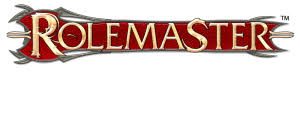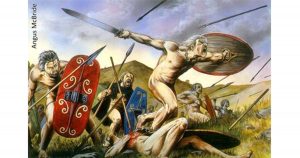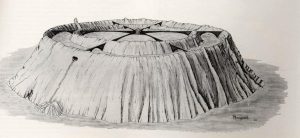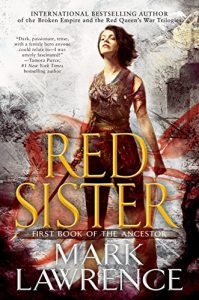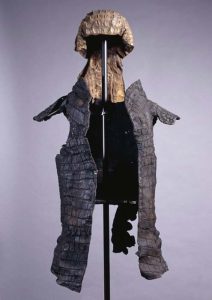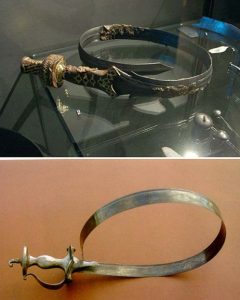Reaching into the archives! One of my first forum posts in the RM forums was way back in 2011. I posted an initial post and then several responses and subsequently have touched upon this in several RolemasterBlog.com posts. Looking back, I see my forum post suffered from push back on profession/class belief and an unrealistic acceptance of my rule proposals! Either way, I think this in a topic worth exploring and I’ve posted a slightly revised version below.
Since its introduction, Rolemaster’s appeal was as a versatile system add-on integrated into traditional Dungeons & Dragons. In RM there are supposedly no class limitations: a fighter could learn spells, and a magic user could wield a sword. At the time (c. 1982) this was a revolutionary feature in fantasy role-playing compared to the strict restrictions imposed in DnD and other gaming systems. The wide adoption of a class based systems was driven by fantasy literature but ultimately led to a creative dead end for the following reasons:
1. Character classes reinforce fantasy tropes. By continuing to use class titles, RM has ultimately embraced a model it was attempting to challenge. Over time, it made it harder to differentiate RM from other established gaming systems as they in turn have adopted some of RM’s ideas.
2. Character classes tend to reinforce the need for the balanced party. While the adventure group is a foundation of traditional fantasy role-playing, it may also pigeon holes players into class defined roles. Furthermore the game balance then breaks down when there are less than 4 players or there is an odd mixture of player classes in the group.
3. Character classes should be driven by the setting, not the other way around. RPG classes have become solid memes: each profession carrying fixed conceptions of its abilities, behavior, appearance or power. The term wizard or magician may conjure up personal fantasy motifs that can overwhelm a GMs unique campaign setting or dispose us to specific actions based on our understanding of that class.
Rolemaster has always identified itself as a skill based system but it didn’t take the concept far enough. The fantasy RPG genre is now a mature industry and new game systems and literature are trying to innovate. Now may be the time for Rolemaster to fully embrace its original mandate: to become a system where a character is truly defined by the sum of his skills and not by accepted class restrictions and aptitudes. By doing so, RMs system can be more easily adapted to any fantasy setting, regardless of its similarities (or lack thereof) to Middle Earth, Greyhawk or any other high fantasy setting.
Discarding character classes does not make the dozens of professions already defined in the original rule set or companions obsolescent: these professions can always be used as Templates. The question of what character class fits into any given world setting never need be asked; instead GMs can create or choose skill cost sets that fit the society, guild, group or organization rather than trying to shoehorn RM character class into their setting
Do you really need different professions for a fighter and barbarian? Are not those differences more defined by racial type, dress, armament and behavior than skill costs? Do you need 3 different classes for magician, alchemist and illusionist? All are Essence users, defined by the family of spells they specialize in rather than a few arbitrary differences in skill costs.
A basic examination shows that skill development costs are still driven by the very tropes that RM should avoid: thieves are weak fighters that rely on stealth; clerics are good and heal; magic users can’ t wear armor etc. If the goal is to eliminate class limitations, then why reinforce fantasy stereotypes or channel character development into these stereotypes?
Problems with my approach.
Moving to a classless system would alienate current RM players. There are already several versions of RM on the market that players can continue to use. Personally, I’ve always used the original RM system and never chose to adopt the new versions. However in terms of changing markets and ultimately RM as a commercial product; does it make sense to undergo a system evolution rather than just another iteration? The development discussion around Arms Law is more than a polishing so why not take a new approach to Character Law?
There is some comfort is settling into traditional gaming roles.
We are currently playing through an Expert D&D module using Castles & Crusades rules. While it feels like putting on a comfortable pair of slippers, its lack of flexibility is already apparent to our group of experienced players. It may just be that if you played a long time, eliminating these stereotypes and expectations can lead to a novel gaming experience. Certainly the latest fantasy literature is moving away from these traditional memes: Erickson, Lynch, Rothfuss are all good examples and it is popular literature that can drive contemporary game design.
There is a strong argument for classes, predispositions etc.
Eliminating classes would homogenize characters and/or create the optimized (min/max) profession. While I haven’t gotten to some suggested solutions yet, I see a place for both a classless system and classes as templates. And no, I’m not suggesting the No Profession option already included in the rule set. There seems to be a belief that an open skill system would lead to player optimization: maximizing key spells, weapons and a few other skills to produce the ideal character. While new rules can still account for that, I would argue that this already occurs under the current system. A quick review of the new character classes, optional rules, talents and background options all point towards the trend to balance individual classes out and then expand their abilities beyond their designed skill cost assignments. In the end you have an exhausting list of optional rules and exceptions that complicates the system and perhaps leads to game imbalance. And all of it really driven by one base motivation: more character flexibility.
A few last thoughts: Is there any really guidance, rules or balance to the current character class generation process? Besides an arbitrary assignment of perceived primary abilities is there a really way to balance classes? Does anyone believe that character classes are equal in balance and playability?
So let’s move on to few ideas.
Step 1. Skill Bonuses.
Before we tackle a skill driven based system we need to look at both skill progression and costs. Perceived character balance is created by the careful structuring of skill costs but may not take into account player motivations. These decision points can be simplified as the sum of three components
1. Additional benefit = (skill bonus increase)
2. Cost of additional benefit = (development point cost)
3. Opportunity Cost = (decision to forego a different skill)
The three of these act as a measure of Marginal Utility, a common economic measurement of consumption and decision making. In simple terms, players look at the cost of a skill, the additional bonus against other skills they may need or want when making their skill picks. Even with high DP costs, most players can afford a versatile selection of skills. That’s because the first 10 ranks offer the highest marginal utility per DP cost AND most skills are limited by a maximum gain of 2 ranks per level. By capping skill rank increases per level you force players to choose the skills that provides them better cost/benefit than CORE skills. In effect this system has an unintended consequence of reinforcing character classes/tropes. So the marketing effort is ‘no limitations’ but is really ‘play by the common rules’.
One way to address this is to modify the skill rank bonus progression. The current system is simple: +5 for ranks 1-10, +2 for ranks 11-20. I would suggest a different approach, starting with Rank 1 a bonus of: +1, +2, +3, +4…..+8, +7, +6, +5, +4 down to +1/2 after Rank 20. Ultimately this gives you the same bonus at Rank 20 you have under the current system. Not only would this change players skill picks since buying 1 rank of a new skill has less utility, but the progression has a more intuitive curve.
As discussed previously, a change to the skill bonus chart will have an affect on player skill picks. This would then be combined with a change to the skill DP costs: basically making skill acquisition limitless at each level with a marginal cost increase per rank per character level.
So while this system can allow a player to increase a skill at a much faster pace than the current system it comes with a much greater DP and opportunity cost. If Caylis had chosen to gain 1 rank per experience level his total DP cost for 8 ranks of that skill would be 16. Instead he used 29. The combined effect of this change to the skill rank bonus and DP cost adds a third dimension to decision making. A player that wants to excel at a particular skill early will be able to do so, but at a substantial opportunity cost of other skills.
The added benefit to this system is that it can not only standardizes character class creation but also allows for a classless system as well. The best of both worlds.
In response to forum feedback:
Despite the thread title, which was meant to be evocative, I’ve carefully stated that this system works for both a skill driven system or applied to the current RM classes. I did skill cost allocations for all of the original 18 classes in about 45 minutes. If players/GM’s want to use the existing classes then it’s easy and quick to adapt. If a GM wants to generate a new class based on his campaign setting then he has a toolkit that allows for an efficient and flexible method. If a player wants to tweak the skill costs on his character than there is baseline for doing so(in this case 162 pts to allocate as skill costs assignments).
I was never arguing removing professions. “Argument against Professions” was meant to strip away preconceptions and then rebuild the class/skill/cost framework consistent with the rules and spirit of the original RM.


